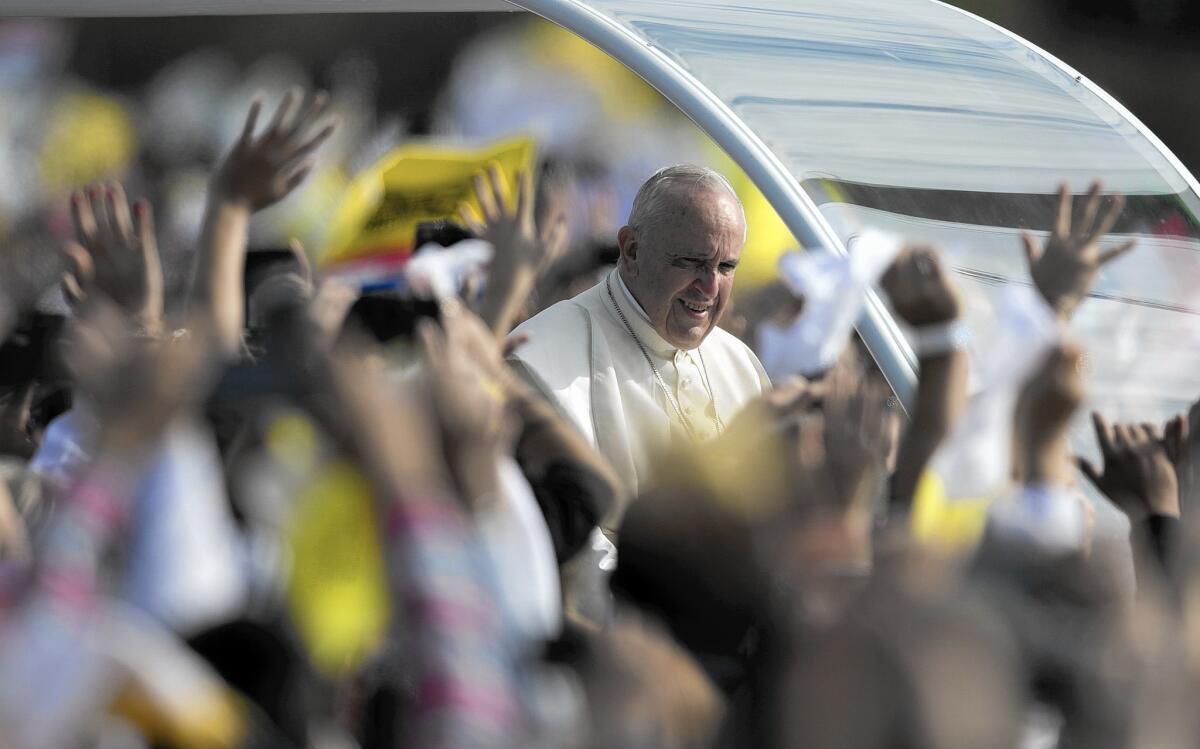In a Paraguay slum, Pope Francis speaks of equality and solidarity

- Share via
reporting from ASUNCION, Paraguay — Concluding a three-country trip to South America, Pope Francis visited a slum Sunday, driving home the message of social inclusion and solidarity with the poor that has been central to his papacy.
“A faith that does not draw us into solidarity is a faith that is dead,” he said, addressing a crowd of thousands in Bañado Norte, a poor neighborhood here in the Paraguayan capital. “Be neighbors, above all to the young and the old. Support young families and all families that are experiencing difficulty.”
Over eight days in Ecuador, Bolivia and Paraguay, every word uttered by the Argentine pontiff was analyzed as Catholics around the world debated the degree to which Francis was nudging the church to the left or simply putting his simple touch on long-standing doctrine. Memorable moments included calling the unfettered drive for money “the devil’s dung” and receiving, albeit with apparent hesitation, a hammer and sickle crucifix from Bolivian President Evo Morales.
But many residents of Bañado Norte, where the pope spoke from a chapel to people gathered on a nearby dirt soccer field, seemed less concerned with ideological debates than with the hope that the pontiff’s visit might bring concrete change to their lives, and soon.
“It was fantastic to hear him talk about equality, right here. Because, obviously, that’s not what we have. Our reality is inequality,” said Sandra Elizabeth de Amarrilla, 37, standing in front of her mother’s tiny brick-and-fiberboard home, near the chapel where the pope had spoken.
She said she hoped local authorities would heed the pope’s message, and she rattled off a list of problems that would be all too familiar to the millions across Latin America who have been failed by decades of botched development.
“We need better healthcare, schools, and we need more safety,” she said. “And we need our rights to land and housing recognized.”
After he left the slum, the pontiff said a large, open-air Mass for hundreds of thousands on the spot where Pope John Paul II canonized a 17th century Jesuit priest, Roque Gonzalez de Santa Cruz, in 1988. There, Francis returned to the theme of inclusion.
The church is about “welcoming the hungry, the thirsty, the stranger, the naked, the sick, the prisoner, the leper and the paralytic,” Francis said. “Welcoming those who do not think as we do, who do not have faith or who have lost it. Welcoming the persecuted, the unemployed. Welcoming the different cultures, of which our earth is so richly blessed. Welcoming sinners.”
“The real work of the church,” he added, “is not mainly to manage works and projects, but to learn how to live in fraternity with others.”
Francis later boarded his Alitalia plane to Rome, waving to crowds and laughing as the wind knocked his cap off his head, much as it had upon his arrival in Ecuador at the outset of the trip.
Francis’ decision to visit a poor area of Asuncion recalled his 2013 visit to a notorious slum, or favela, in Rio de Janeiro during his first visit as pope to his native South America.
In Bañado Norte on Sunday afternoon, 60-year-old painter Pablino Olmero leaned back on a log alongside an unpaved road and remembered that when Pope John Paul II visited here in 1988, he didn’t get a chance to see him. At the time, dictator Alfredo Stroessner was still in power, but was ousted the next year. His Colorado Party, however, is back in power.
“Today was amazing. Beautiful,” Olmero said. “But what we really want is it to mean something for the country. We want the politicians to listen. Well, I’m sure they did listen — they have to, it’s the pope.
“But” — he laughed — “my fear is that it will go in one ear and out the other.”
Bevins is a special correspondent
More to Read
Sign up for Essential California
The most important California stories and recommendations in your inbox every morning.
You may occasionally receive promotional content from the Los Angeles Times.












